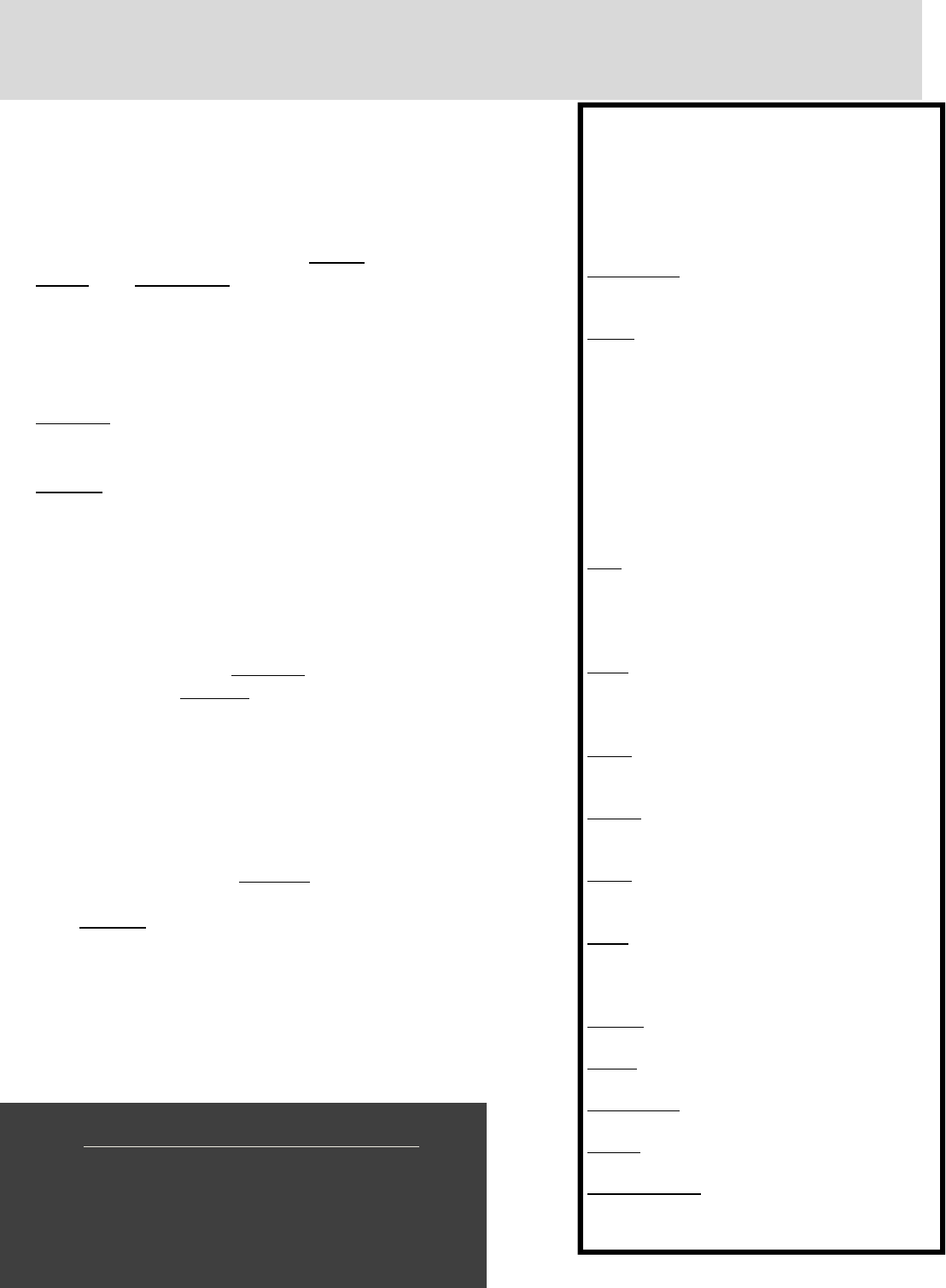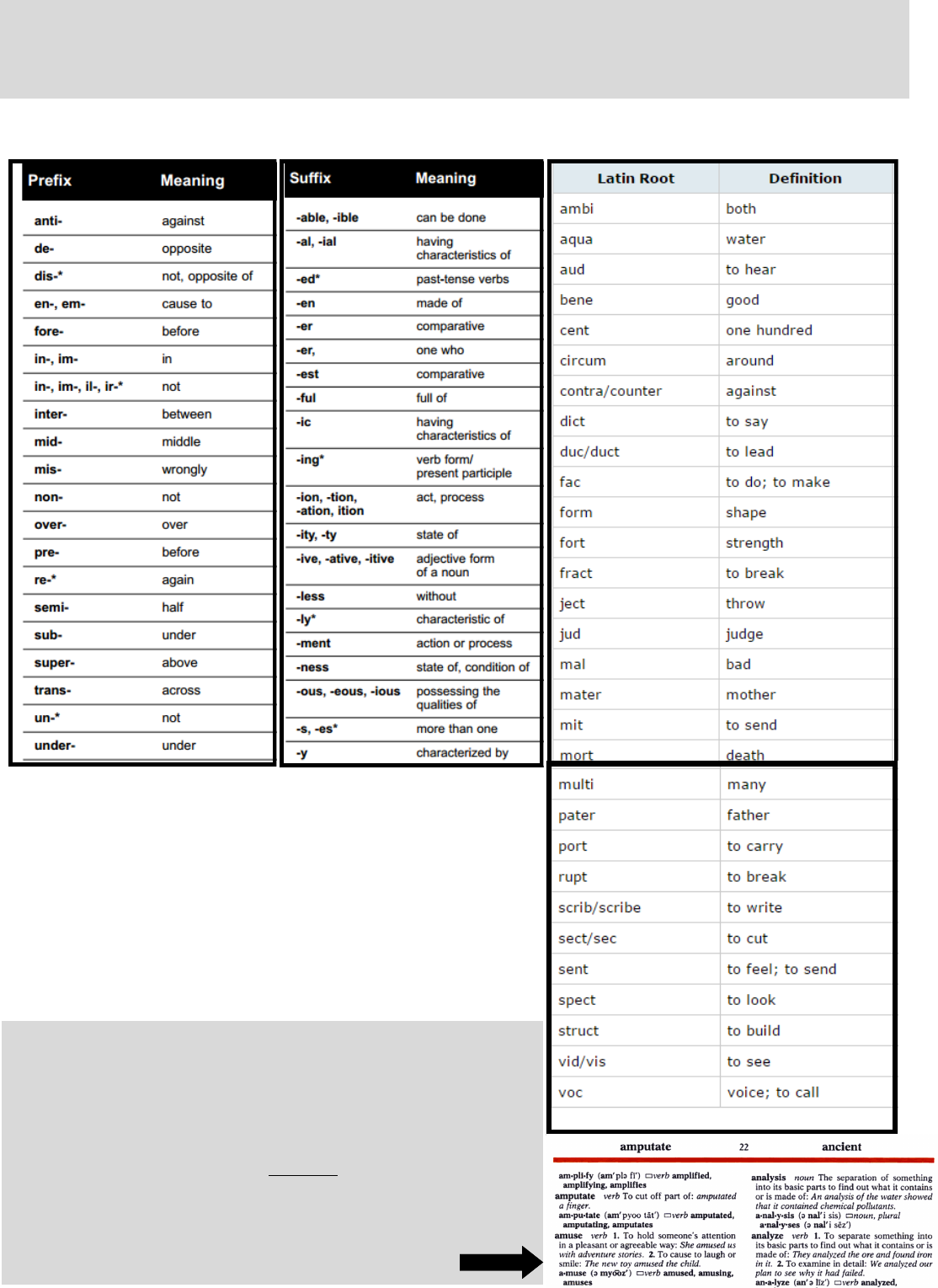
What Every Rising 7th Grader Should Know:
English/Language Arts
Your rising 7th Grader should be able to use
the following strategies to nd the meaning of
unknown words in a text:
Context Clues: Words around the word that
give you a hint to what they word may
mean. Example: Stacy slammed the door
and stomped to her room. She was exacer-
bated. Does exacerbated mean a) annoyed,
b) excited, c) terried, d) overjoyed?
Answer________________________________
Apposives: An apposive is when the
author puts the meaning of the word di-
rectly in the sentence. Example: The
arachnids, or spider family, has a long
history of scaring people with arachnopho-
bia. What is the meaning of the word
arachnid. A) spider fear, b) spider food, c)
spider family, d) spider home?
Answer_________________________________
Opposite meaning: An author may use
details to show what a word does NOT
mean. You can use these clues to help you
nd the meaning of a word. Example: Carrie
was excited about going to the meeng
unlike her sister who was reluctant. In this
sentence the word reluctant means:
a) hesitant, b) excited, c) furious,
d) ancipang
Answer_________________________________
Plug It In!: When you think you might know
a word’s meaning, plug it in. Replace the
word with the denion and then REREAD
the sentence to see if it makes sense.
Example: Charles violently throled Desn
unl his arms hurt. In this sentence the
word throled means a) cursed, b)
punched, c) hugged, d) signaled
Answer ________________________________
Answer Key
Context Clues: A
Apposives: C
Opposite Meaning: A
Plug It In!: B
Many words we use in the English Language are
borrowed from languages all over the world. We
call these words loan words OR borrowed words.
Knowing the origins and meanings of these words
will help your student navigate through more
complex texts.
Common Loan/Borrowed Words:
Scandinavian
Blight Doze Kindle Scathe Scorch Sly
Thrall
French
Aorney Baili Chancellor Jury Noble
Parliament Plea Revenue Verdict Chaplain
Clergy Sacrament Baron/Baroness Count/
Countess Duke/Duchess Noble Arllery
Corporal Marine Sergeant Broil Butcher Dine
Muon Poultry Veal Claret Oboe Pendant
San Devout Enamor Feign Pilgrimage
Cachet Chic Faux Pas Rouge Sachet Salon
Brigade Baalion Cavalry Infantry Bigot
Clique Grotesque Niche
Lan
Agile Abdomen Anatomy Capsule
Compensate Dexterity Excavate Ficous
Gradual Habitual Meditate Notorious Orbit
Peninsula Physician Vindicate
Greek
Anonymous Atmosphere Catastrophe Climax
Cric Data Ostracize Parasite Pneumonia
Tonic Tragedy
Arabic
Alcove Zenith Algorithm Almanac Alchemy
Admiral Cipher Saron
Spanish
Armada Adobe Barricade Bravado Cannibal
Canyon Desperado Embargo Mesa Vigilante
Italian
Arsenal Cameo Duo Gazee Groo
Moo Stanza Tempo
Dutch
Buoy Freight Keel Reef Scour Splice
Spool Easel Etching Sketch Holster
Furlough Onslaught Uproar
German
Lager Hex Lager Delicatessen
Yiddish
Dreidel Kosher Spiel Schlemiel Klutz
Scandinavian
Fjord Maelstrom Smorgasbord
Russian
Czar/Tsar Icon
American Indian
Maize Hammock Hominy Papoose
Squaw Terrapin Toboggan Wigwam
Resource: For more words that Rising 7th Graders should know try
this link to Quizlet: 100 Words 6th Graders Should Know—
hps://quizlet.com/18654274/100-words-6th-graders-should-
know-ash-cards/
Start with the “Access” buon to learn the words. Then click
“Learn” to test your skills. Good Luck!

What Every Rising 7th Grader Should Know:
English/Language Arts (page 2)
Direcons: Create ash cards with the prex/sux/root on the front and its meaning on the back. Study these ash cards for 20
minutes a day in order to be able to understand new vocabulary words.
Direcons: Use your knowledge of root words, prexes, and suxes in or-
der to create words to complete the sentences.
1. If I write over a line it is called super____________________.
2. If I write under a line it is called __________________script.
3. If I am moving across connents I am _______________connental.
4. When I break up a conversaon I inter___________ it.
5. Someone who acts without thinking is thought_________.
ROOT
PREFIX
PREFIX
ROOT
SUFFIX
Answers:
1) Script , 2) Sub, 3) Trans, 4) Rupt, 5) Less
Using Resources
Dictionary: A diconary is a book lled with denions of words that make up a lan-
guage. Use a diconary to look up: Correct spellings, Pronunciaons, Denions,
Parts of speech, Word origins (what other languages the word came from).
Thesaurus: A thesaurus is a book of words and their synonyms (words with similar
meanings). Use a thesaurus to help you nd new ways to say words you use
commonly—they are a great tool to expand your vocabulary!
Important Note about GUIDE WORDS: Guide words (or Key words) appear at the tops
of pages in diconaries, encyclopedias, and other reference books. They let you know what
informaon can be found on each page. The guide words tell you the rst and last words (or
topics) that will be dened or discussed on that page, leng you know that words alphabecally
in-between are listed there as well. For example: If the guide words were amputate and
ancient, you would know that “ambiguous” would not be on that page BUT
“analyze” would be.

What Every Rising 7th Grader Should Know:
English/Language Arts (page 3)
Fiction
Fiction is a genre of literature that uses Characters (who the story is about),
Setting (location, time in history, time of day), and Plot (the events that happen in
the story) to convey events that are not real.
Science Fiction: a fictional story that is often set in the future. It usually has
elements of science, technology, space, and/or time travel
Historical Fiction: a fictional story that uses real events that happened in
the past and real historical figures but tells a story that is not real
Realistic Fiction: a fictional story often set in the present that has believable
characters, setting, and events that could actually happen (plot)
Fantasy: a fictional story that has unusual elements (magic, vampires,
werewolves) that are not likely to happen in real life
Mystery: a fictional story that has a puzzle or a crime that needs to be
solved. The main character is often a detective and the puzzle/crime isn’t
solved until the very end.
Folktale: a fictional story told among a group of people who share a
culture. Usually folktales are passed down orally from one generation to the
next.
-Tall Tale—a form of folktale that is usually humorous. It could be
about real person or a made up character but the story will
include unbelievable exaggerations.
-Myth—a form of folktale that is considered sacred. This may include
stories about a creator, gods, and how things came to be.
-Fable—a form of folktale that often teaches a moral lesson using
talking animals as characters
-Legend— a form of folktale that is based on a real person or event
but cannot be proven true
- Fairy Tale—a form of folktale that has unrealistic characters
(wizards, fairies, magic), unrealistic events (magic
pumpkins, poisoned apples that make you sleep), and a
happy ending. Often they begin with “Once Upon a Time…”
Direcons: Create ash cards for each Genre (Ficon, Noncon, Drama, Poetry) and Sub-Genre (Science con, Arcle, Fantasy,
etc.) Study ash cards for at least 20 minutes a day. When reading books this summer try to idenfy the genre of each using the
characteriscs below.
Non-Fiction
Non-Fiction: A genre of literature that gives true facts about real-life topics.
Biography: a non-fiction text that is the true story of a person’s life written by someone
else. The events in this text are usually told in chronological order (order in which they
happened)
Autobiography: a non-fiction text that is the true story of a person’s life written by or told
by THAT person.
Essay: a non-fiction text that reflects the author’s outlook or opinion about a topic and is
usually meant to persuade the reader to agree with the author.
Speech: a non-fiction text that is a transcript (word for word) of a public address (speaking
publically), usually by a well known person.
Textbook: a non-fiction text that is a trustworthy and detailed description about a topic
(Math, Science, Geography) that is supported by true facts
Reference Book: A non-fiction text that is used as a quick source of factual information
(dictionary, encyclopedia, almanac, atlas, etc.)
Newspaper Article: a non-fiction text that is a factual account of an important event. The
writer shows all sides of the issue (pros/cons, good/bad) and gets their information from a
credible source (a source that can be trusted to tell the truth)
1.) Once upon a time there was young girl and boy who get lost in the
woods and stumble upon a gingerbread house. They eat a bunch of it,
until they find out it’s a magical witch’s house. She enslaves them, cages
them, and feeds them candy to fatten them up as she intends to eat them.
Will they kick her into the oven and escape?
Circle the Genre: Fiction Non Fiction
Circle the Sub-Genre:
A) Folktale B) Mystery C) Fairy Tale D) Historical Fiction
2.) A book that contains brief overviews of major events in American
history. It was created for students to learn about the colonization of
Jamestown, George Washington, the Civil War, and more.
Circle the Genre: Fiction Non Fiction
Circle the Sub-Genre:
A) Essay B) Textbook C) Article D) Speech
3.) It is the story of a young boy who lives with his family next door to one
of America’s founding fathers, Benjamin Franklin. This young boy finds
Franklin conducting some kooky experiments, overhears some of Franklin’s
secret meetings, and has the opportunity to help in a big way.
Circle the Genre: Fiction Non Fiction
Circle the Sub-Genre:
A) Folktale B) Mystery C) Fairy Tale D) Historical Fiction
4.) In this text the author discusses the horrible conditions and over-
crowding present in many animal shelters and kennels. She tries to
convince readers to adopt these animals and argues the many virtues of
dog ownership.
Circle the Genre: Fiction Non Fiction
Circle the Sub-Genre:
A) Essay B) Textbook C) Article D) Speech
Answers:
1) Ficon: Fairy Tale , 2) Non Ficon: Textbook, 3) Ficon: Historical Ficon, 4) Non Ficon: Essay

What Every Rising 7th Grader Should Know:
English/Language Arts (page 4)
Student Editorial
If schools don't want to remain in the Dark Ages, they have to allow students to bring cell phones to our classes. They have
become an essenal part of our lives, and almost everyone has one or wants one.
If for no other reason, we need to have cell phones with us for safety. Our parents want us to have them so that if anything
happens, we can get in touch with them right away. I read that my favorite teen actress, Sara Jackson Milford, carries a cell phone to
her school so that she can call her home or her agent whenever she wants. My mom says that she has more peace of mind because she
knows that I can call her whenever I need her.
Parents call us on cell phones for lile everyday things, too, like reminding us of a dental appointment or a piano lesson, or tell-
ing us about a change in plans aer riding the bus home instead of waing to be picked up at school. Cell phones simplify things for
everyone.
Cell phones that can take pictures are helpful, too. You can use them for class, for photo essays and things like that. They are
even being used to help solve crimes. In Australia, neighborhood watch groups are using cell phones in policing their communies. In
Japan, people can send pictures directly to the police. Having cell phones in school could help cut down on vandalism or other inappro-
priate behavior as any student could click a picture of the culprit and share it with the principal or the authories.
The students at one high school in Florida helped to convince state legislators to change the law that banned cell phones in
schools. Now individual school districts set their own policies. At this Florida high school, students can have cell phones at school, but
they have to be turned o and kept in their lockers. Sll, they get to have them there to that they can use them as soon as school is out.
The principal said that most of the 1,700 students there have cell phones.
There’s no point in scking our heads in the sand. The world is changing quickly, and our school policies need to change to
keep up with them. Cell phones are just a fact of life. They aren’t going away.
School Representave Editorial
Our school district policy has forbidden cell phones and pagers from the me they rst began to appear on our campuses.
Originally we feared that they might be used for inappropriate acvies. Today the picture has changed, and cell phones are much
more commonly used. But that does not mean students can use their cell phones whenever and wherever they like. For their own
good, students need to comply with school policy.
Think about the last me you were in a theater and someone’s cell phone rang. It is very annoying to have an evening’s enter-
tainment interrupted by someone’s thoughtlessness. Now, imagine a classroom in which someone’s cell phone suddenly rings in the
middle of a discussion or a test. It is even more disrupve in such a situaon. Students insist that they would remember to turn them
o for class, but we know that would not work. Parents need only consider how forgeul young people can be to know that probably
more than one cell phone would be ringing during class me. I have children of my own, and I realize that there are both advantages
and disadvantages to having cell phones at school. It is my sincere belief that the disadvantages outweigh the advantages.
If a crisis, such as a re, were to occur at school, cell phones in the hands of hundreds of students would not help the situaon.
In fact, it would hurt. Rescuers might be prevented from receiving the call for help as too many calls would ood the available phone
lines. Also, parents receiving calls could quickly ood the area, geng in the way of reghters and rescue worker. Just having so many
calls being made could also overload cell phone systems and interrupt communicaon among emergency workers.
Unfortunately, cell phones can also be used for less acceptable reasons than communicang with parents. Text messaging al-
lows students to communicate silently during a test, oering a new form of distracon. Also, phones that snap pictures can be used to
invade the privacy of others in a number of unpleasant ways. Adults cannot be present in every corner of a school monitoring the stu-
dents’ use of cell phones.
Our policy has been developed with the well-being of the students in mind. Providing a learning environment that is as peace-
ful and secure as possible is our goal. Cell phones interfere with creang such an environment.
1) In the student's editorial, what is the main
idea of the third paragraph?
A) Cell phones can help students keep
Appointments
B) Cell phones make it easier for parents to
contact students
C) Students often have appointments like
piano lessons after school
D) Parents have to call the school office to
send messages to students
The Topic is what the passage is about. The Main Idea is a statement that tells
the author’s position, or how the author feels, about that topic.
What is the topic of the Student Editorial?
In the third paragraph (paragraphs start with a space called an
Indentation) what is the authors position on the topic?
Answer: B

2) How is the Student Editorial organized?
A) by describing the process of parents getting
cell phone for their children
B) by telling the reasons for and positive effects
of cell phone usage
C) by presenting a problem concerning cell
phones and how it can be solved
D) by including questions about cell phone
usage in school followed by answers
It is important that a reader understand the way a text is structured so that they
know how to locate information within that passage. Some common text struc-
tures are:
Cause and Effect: Cause is why something happened. Effect is what happened.
Compare and Contrast: Shows how two or more things are alike and/or
different
Sequence: Describes items or events in order or tells the steps to follow to do
something/make something
Problem and Solution: Tells a problem then gives one or more possible
solutions
Description: A topic, idea, person, place, or thing is described by listing its
features, characteristics, or examples
What Every Rising 7th Grader Should Know:
English/Language Arts (page 5)
3) Which one of these statements is an
opinion?
A) Our school district policy has forbidden cell
phones and pagers from the time they first
began to appear on our campuses.
B) It is very annoying to have an evening’s
entertainment interrupted by someone’s
thoughtfulness.
C) In Australia, neighborhood watch groups are
using cell phones in policing their communities.
D) The students at one high school in Florida
helped to convince state legislators to change
the law that banned cell phones in schools
A Fact is a statement that can be proven true or false
An Opinion is a statement that shows what someone believes or feels
Opinions have words that show bias. Bias is what a person prefers.
What word(s) in the sentences below shows what the author prefers?
Dogs are better than cats.
Presidents are more effective when the only serve 2 years.
The orange dress is the prettiest.
4) The School Representative will most likely
A) Allow students to bring phones to school
B) Hold a meeting with students to change cell
phone policy
C) Speak with the Board of Education to reconsider
the current cell phone policy
D) Reinforce the current punishment for students
bringing cell phones to school
Questions like these ask students to Draw Conclusions. Drawing Conclusions
means you must access your schema (what you know about life) and textual
evidence (what the text says) to create a new idea.
What do you know from the text about the School Representative?
What do you know from the text about the school’s cell phone rules?
What do you know from your own experience about having a cell phone in school?
What will the School Representative
most likely
do next?
